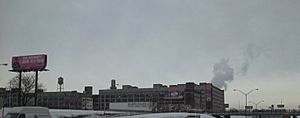Russell Industrial Center facts for kids
The Russell Industrial Center is a large group of buildings in Detroit, Michigan. It used to be a factory, but now it's a lively place where artists, creative people, and different businesses have their studios and shops. This huge complex has seven buildings and covers about 2.2 million square feet. It was designed in 1915 by a famous architect named Albert Kahn for John William Murray.
The Murray Body Corporation, which supplied car parts to companies like Ford, built the complex in 1924. They were one of the biggest car body makers in the U.S. Later, in 1955, the company stopped making car parts and focused on other things. In 2003, Dennis Kefallinos bought the Russell Industrial Center. He turned it into over a million square feet of studio space for artists and businesses. The center now works with non-profit groups, local colleges, and other businesses.
Contents
History of the Russell Industrial Center
Early Days and John William Murray
John William Murray was born in 1862. In 1913, he started the J W Murray Mfg. Co. in Ann Arbor, Michigan. His company made metal parts for car factories in the Detroit area. The first factory was on Clay Street in Detroit, right next to the Grand Trunk Western Railroad line. Murray's company started making car bodies, fenders, hoods, and frames. Many car companies, like Dodge and Ford Lincoln, needed his parts. This made Murray's business grow very fast.
Albert Kahn's Design
To meet the high demand, Murray hired architect Albert Kahn in 1915. Kahn was a top industrial architect in Detroit. He was known for designing large factories using concrete. His designs were strong and fireproof. They were also cheaper to build and had lots of open space inside. Kahn's buildings also had many windows. This brought in lots of natural light for the factory workers.
Growth and Changes
In 1924, J W Murray Mfg. Co. joined with other companies. They formed the Murray Body Corporation. After this, they became the third largest car body company in the United States. John William Murray retired soon after the merger.
In the 1940s, the Murray Corporation helped with the war effort. They made military supplies, like airplane wings and parts for fighter planes. They also made washing machines. After the war, many people moved from Detroit to the surrounding suburbs. This led to a difficult time for the Murray Corporation. They continued making car parts until 1955.
New Owners and Challenges
In 1960, a company called Packard Properties bought the complex. They renamed it the Russell Industrial Center. They started renting out space to different businesses. They called it an "apartment house for industry." Many manufacturing and distribution companies moved in.
Later, in 1970, Leona Helmsley bought the complex. She sold it in 1991. In 1998, a tornado and storm hit the Russell Industrial Center. The building was damaged, and its power system was destroyed. The company that owned it at the time faced financial problems and could not fix it. The building was empty and falling apart for a while. Then, Dennis Kefallinos bought it for one million dollars.
In 2017, the building had some safety issues. It was ordered to be emptied for a short time. But by 2018, these problems were fixed. The Russell Industrial Center is now a thriving place for small businesses and artists. Over one hundred businesses and artists call it home.
Renovation and Art
Transforming the Space
Albert Kahn's building was made of strong concrete and had many windows. This made it perfect for art studios. Dennis Kefallinos decided to create many studio spaces for artists. His work is a great example of how old industrial buildings in Detroit are being brought back to life. Turning an industrial building into lofts for artists helps to promote the arts and renew the city.
In 2010, an artist named Kobie Solomon painted a large mural. It's called the Detroit Chimera Graffiti Mural and is on building number 2.
Events at the Center
Russell Bazaar
The Russell Bazaar is an indoor market held on the first weekend of every month. More than 150 local sellers and artists come to sell their goods. You can find all sorts of unique items there. The management makes sure there's a good variety of products. They prefer booths that sell original or special merchandise. Each month, one booth is offered for free to help raise money for a non-profit group called The Russell Industrial Center for Creative Studies.
People's Art Festival
The annual People's Art Festival is a big event open to everyone. It features lots of art, entertainment, food, and things to buy. It takes place in the courtyards of the complex. Some of the artists who have studios there even open their doors so visitors can see their workspaces. Besides art and shopping, there's live music from local musicians on several stages. Admission to the festival is free. It's sponsored by non-profit groups and local businesses. This event helps connect the city with Detroit's creative community and supports the arts.


